Don’t fix what’s not broken.
But it’s important to stop, evaluate and grow with the times.

In order for companies to scale, access to information and ability to collaborate with internal teams and customers alike has become paramount.
THE ANATOMY OF A SUCCESSFUL PROJECT PLAN
1) INITIATION The starting point of any planning process should begin with the creation of a Project Charter. This document becomes the backbone of the project and it’s goal on a high level, is to:
Identify the business case
Describe team roles & main stakeholders
Carry out due diligence to decide feasibility
Identify the risks and benefits of the project
Overview of the budget
2) PLANNING
This is the ‘brain’ stage, if you will, where the project management roadmap is outlined with a Project Scope Statement. This document includes identifying project boundaries, available resources, deliverables and key milestones to keep the team and project on track. Mapping out a realistic timeline and projections with these markers will allow the Project Manager to get as close to a successful outcome as possible. This should be kept short and sweet, and shareable across departments to enable collaboration. With the help of automated systems you can create a project, generate playbooks, allocate a team and allocate budgets. 3) EXECUTION Starting with a ‘kick-off’ meeting, this stage is where all the limbs start working together like a well-oiled machine. Based on forecasts in the planning stage teams set up meetings, develop and complete milestones, map progress of deliverables, track project against baseline, tasks are assigned & tracked, update & modify project budget as needed.
4) CONTROL
This is the more technical stage of the process. Here is where the project progression is monitored, to make sure that departments are working as they should and still aligned to achieving the project plan. This phase can also be easily enhanced by automation to measure whether projects are on schedule, track capacity utilization and budget. For any unforeseen issues that may arise, it is important the team remains agile. The Project Manager is then able to adjust the plan accordingly and provide real-time status reports to stakeholders.
5) CLOSURE
The be-all end-all stage of project planning. There is generally a ‘post-mortem’ analysis carried out at this point. Project milestones are reviewed to see what worked, what didn’t and how it could be improved, feedback is captured from the team, customers and stakeholders. A final project financial report is also created by the Project Manager.

Managing projects remotely on Salesforce, Precursive Playbook
“There’s not really a price tag that you can put on good planning”
Ryan Sullivan
/ PowerPivotPro



תגובות